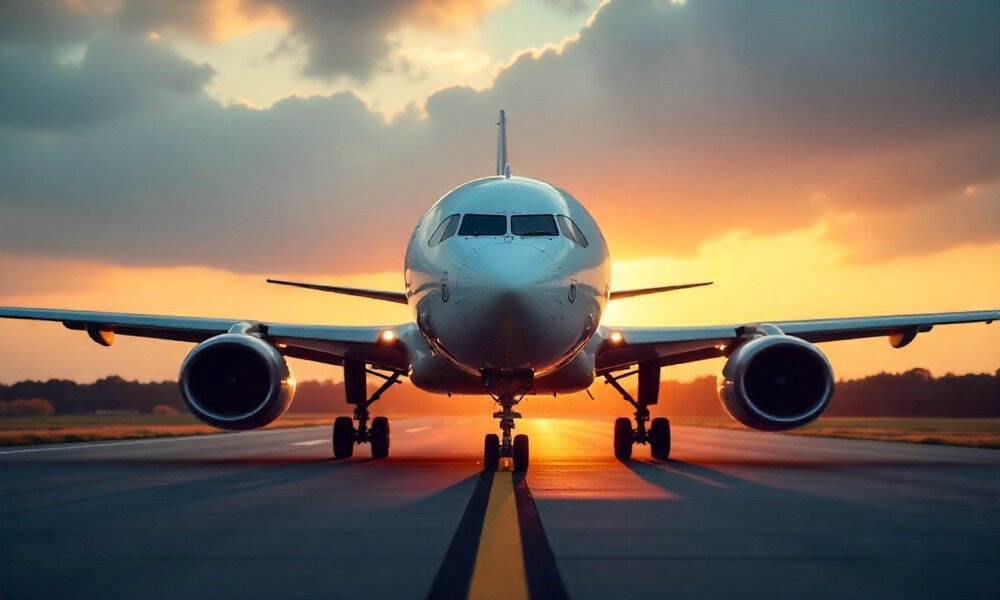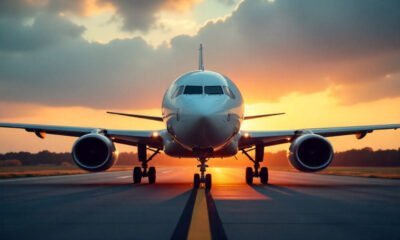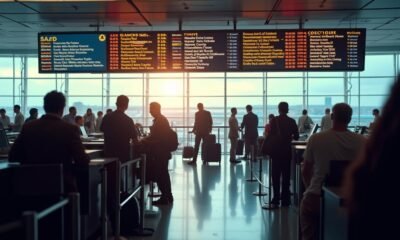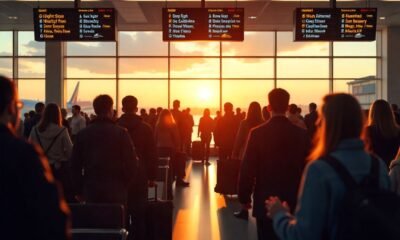Flight Buzz
Travel Plans Wrecked Across the US and Canada as Delta, Air Canada, Southwest, Alaska, and More Airlines Cancel Over 120 New Flights Disrupting Trips Across North America

Wednesday, July 30, 2025
Passengers were left stunned yesterday as well over 120 commercial flights were suddenly cancelled throughout the US and Canada, causing chaos for travelers as major airlines like Delta, Air Canada, Southwest, Alaska Airlines and United experienced mounting operational stress due to complaints of plane routing woes, staffing shortages and summer time system congestion. The fast-traveling cancellations to both regional and long-haul routes trapped thousands of travelers or forced them onto longer, alternative routes, throwing a wrench into travel around North America at one of the busiest times of the year. It was a striptease of stranded planes dressed in steps from major airports in Chicago, Los Angeles and Toronto to regional airstrips throughout both countries, the domino-like shutdown of scheduled flights exposed that the air travel network remained as fragile as ever, under strain from soaring demand and little room for airlines to maneuver.
Across the US and Canada, a total of 117 flights were cancelled and 4,040 were delayed within, into, or out of the region, disrupting schedules for thousands of passengers. United Airlines led with 40 cancellations—representing 1% of its scheduled operations—and 442 delays, accounting for 14% of its flights. Delta Air Lines followed with 17 cancellations and 386 delays, while Southwest Airlines cancelled 13 flights and reported 600 delays, both reflecting about 10–14% disruption rates. PSA Airlines recorded 12 cancellations, or 1% of its network, with 153 delays affecting 21% of its flights—the highest delay rate among the listed carriers. Air Canada and its subsidiaries, including Rouge and Porter, accounted for a combined 9 cancellations and 145 delays. Alaska Airlines cancelled 6 flights and delayed 98, while American Airlines and SkyWest each logged 3 cancellations with 645 and 275 delays respectively. Although some carriers like JetBlue, Frontier, and WestJet Encore reported only one cancellation each, their percentage of delayed operations still exceeded 14%, revealing the widespread and systemic nature of the day’s aviation gridlock.
Over 120 Flights Cancelled in a Single Day Across North America
North American travelers were hit with a wave of cancellations yesterday as more than 120 flights were abruptly grounded across the United States and Canada. The widespread airline cancellations disrupted tightly packed summer itineraries, affecting everything from short-haul commuter routes to long-haul transatlantic journeys. Travelers on both sides of the border found themselves stuck in terminals or forced to abandon trips altogether.
United Airlines Grounds Flights From Coast to Coast
United Airlines cancelled 40 flights, the highest of any carrier in the region. From Los Angeles to Newark, and from Kahului to Chicago, passengers were left stranded with little warning. Several high-impact routes were affected, including United’s international service from Washington Dulles to London and its intercontinental flights from Hawaii to the mainland.
The airline’s extensive cancellations not only halted domestic connections but also severely impacted international travelers trying to reach Europe and major U.S. gateways. With a fleet that includes widebody Boeing 777s and Dreamliners, United’s grounded long-haul aircraft created ripple effects across its entire network.
Delta Cancels Summer Flights Amid Network Constraints
Delta Air Lines followed with 17 flight cancellations, targeting key city pairs in the southeast, Midwest, and West Coast. Flights from Seattle, Detroit, Orlando, and Los Angeles were among those cancelled. Although the number appeared lower than United’s, the impact was widely felt due to the airline’s heavy reliance on hub-and-spoke routing.
The affected flights included both domestic short-hauls and strategic trans-regional routes essential to business and leisure travelers navigating the summer peak.
Southwest and Alaska Cancel Flights Across Western US
Southwest Airlines cancelled 13 scheduled flights, hitting travelers in the western U.S. the hardest. Disruptions at San Diego, San Jose, Phoenix, and Burbank created challenges for travelers flying between major California and Arizona cities. These routes typically serve high volumes of weekend travelers and commuters, intensifying the consequences of even a single flight being pulled from service.
Alaska Airlines added to the operational halt with six flight cancellations. The Seattle-based carrier cancelled routes between Portland, Los Angeles, and Dallas, creating significant gaps in its West Coast-to-interior US connectivity.
Air Canada and Canadian Carriers Halt Domestic Routes
Air Canada was forced to cancel four flights across major Canadian airports, including routes between Calgary, Montreal, and Vancouver. Additional cancellations came from Air Canada Rouge and Porter Airlines. These disruptions disrupted not only domestic connections but also cross-border traffic into the United States, leaving North American travelers with fewer alternatives and longer wait times.
In total, Canadian carriers accounted for nine cancellations, a notable share of the North American total.
Regional Airlines Amplify the Grounding Crisis
PSA Airlines, a regional affiliate operating under the American Eagle brand, cancelled 12 flights concentrated around its Charlotte hub. Affected destinations included mid-size airports across the South and Midwest, worsening connectivity to smaller cities. SkyWest Airlines cancelled three additional flights, with other regional operators like JetBlue, WestJet Encore, and Frontier adding isolated cancellations that contributed to the broader collapse in flight availability.
Airline Cancellations Cripple Trip Plans and Passenger Mobility
Unlike delays, cancellations often leave travelers with no same-day alternatives. Many affected passengers were rebooked for next-day flights or advised to seek refunds and make their own arrangements. With the majority of cancellations concentrated in the peak afternoon and evening travel windows, families, business travelers, and international flyers were disproportionately impacted.
Social media reports flooded in from airports in Chicago, Newark, Vancouver, and Los Angeles, where passengers described chaotic rebooking lines, hotel shortages, and ruined itineraries. Some travelers missed milestone events, including weddings and cruises, while others were forced to postpone work trips and vacations entirely.
Operational Fragility Exposed During Peak Travel Period
While airlines have not yet released full explanations for the coordinated cancellations, aviation analysts suggest a combination of staffing constraints, aircraft rotations, and unplanned maintenance may have been contributing factors. During high-travel months, even a modest spike in system stress can force multiple carriers to cancel scheduled departures to stabilize schedules.
Yesterday’s sharp spike in cancellations underscores the continued vulnerability of North America’s air travel infrastructure. The inability to absorb demand surges or handle mild disruptions without grounding flights continues to put the burden on passengers—especially during the peak of summer travel.
Over 120 flights were cancelled across the US and Canada as major airlines like Delta, Air Canada, Southwest, Alaska, and United grounded aircraft due to staffing shortages, aircraft rotations, and peak summer congestion, leaving thousands of trips disrupted across North America.
North American Passengers Left in Limbo
With more than 120 flights cancelled in a single day, travelers across the US and Canada were reminded that even in a post-pandemic recovery era, flight reliability remains elusive. United, Delta, Air Canada, Southwest, and Alaska—all major players—were responsible for the vast majority of cancellations. Combined with regional carriers halting additional services, the impact extended from major international hubs to smaller regional airports.
Thousands of trips were wrecked in less than 24 hours, reinforcing the growing public concern over air travel stability across North America.
Flight Buzz
Traveller’s seatbelt trick for ‘sleeping like a baby’ on long flights prompts warning: ‘Scared’

There are so many amazing things about taking an overseas holiday. You get to experience new and intriguing places, try new cuisines, see sights you might be familiar with from movies and hopefully switch off from the demands of life for a while.
Although Aussies love to travel and are known as a fairly intrepid bunch, it cannot be denied that taking an international trip from Down Under to pretty much anywhere can be torturous because it takes so damn long! And, if you are in an economy seat, it can feel like even longer.
It’s no wonder that travellers will go to the ends of the earth trying to find ways to make long-haul flights bearable and to find travel hacks that promise a decent stretch of sleep.
However, after one tourist shared a controversial travel hack for sleeping on flights, her followers expressed concerns about the trick’s safety, and a vascular surgeon tells Yahoo Lifestyle that she would not recommend it.
In a TikTok that has been viewed 560k times, Lindsay (@linzi_who) demonstrates the unusual position she found that helped her get some rest on a flight.
RELATED:
Traveller’s flight sleep hack divides
“Now this is the travel hack we all need to know,” she says in the clip. “Extend the seatbelt as far as you can, put your legs up, wrap it around your ankles, plug it in and look nice and tight. Then I turn sideways, put my head against the back of the chair, and honestly, I slept like a baby.”
While Lindsay says the hack “made sleeping on the plane so much easier”, the video attracted more than 200 comments from people who saw nothing but issues.
“I’m 5ft 11, no chance I could do that lol,” one person said while someone else said it wouldn’t work for them as they are 6’2.
“I mean that would never work for us plus-sized girlies 😩😩😩,” another person lamented.
“My knees after that would a hundred per cent not stretch out without a cry of pain and help 💀😂,” someone else added.
“Hard to do when you have your 9-month-old on your lap 😂😂,” was another comment.
Another person said that they “got told off” when they attempted the trick.
Other travellers were more open to the idea, with a couple of them saying they intended to try the trick themselves on their next flight.
“I do this without turning to the side, and it was the most comfortable way I’ve found on long-haul flights,” one person commented.
Travellers concerned about risks of flight hack
There were also plenty of comments from people who said that they would be too concerned about deep vein thrombosis (DVT) to attempt the seat hack.
DVTs (blood clots) can occur when people sit still for long periods of time, as this slows down blood flow in the legs. A lack of movement greatly increases the chances of a clot forming, and if that blood clot breaks loose, it can travel through the bloodstream to the lungs, causing a blockage called a pulmonary embolism, which can be life-threatening.
“I’d be too scared of DVT,” one said.
“Yeah, like you don’t higher the risk of a blood clot when you travel like this. Good luck,” added another.
“Enjoy your DVT,” a third wrote while someone else commented, “DVT… 🤔 You shouldn’t sit like that on an aeroplane.”
Expert’s warning over dangerous seat hack
Dr Pecky De Silva, a vascular surgeon and Councillor at the Royal Australasian College of Surgeons, tells Yahoo Lifestyle that the detractors of the travel hack are absolutely right and that staying in that position could indeed be dangerous.
“The practice shown on the video would increase your risk of deep venous thrombosis because of the immobility of the limbs held in place by the safety belt, but also because of the position of the legs, causing compression of the major deep vein behind the knee,” she tells us.
And, replying to the many viewers of the TikTok who wondered about the safety of the trick during turbulence, Dr De Silva says she agrees with them too.
“My other concern would be that during severe turbulence, the safety belt wouldn’t keep you safe, and you would be at risk of flying up and hitting your head,” she says. “Altogether, I would definitely be advising my patients against this practice.”
How to prevent DVT on long haul flights
If you are lucky enough to have an international flight coming up, there are several things you can do to minimise the risk of DVT.
SHOP:
For starters, you should wear comfortable and loose fitting clothes (pretty standard attire for a long flight anyway) so you can move freely. However, wearing compression socks is a great idea too – particularly for anyone who is at a higher risk of clots, such as women on the birth control pill.
And, although it can be so tempting to relax with a few glasses of wine during your flight (you are on holiday, after all!), it is recommended that caffeine, alcohol and sleeping pills be avoided. Instead, try to drink plenty of water which will keep you hydrated and could even help to minimise jet lag.
And, of course, it’s important to try to get up and move around as much as possible during the flight to increase circulation and prevent muscle soreness and stiffness.
Flight Buzz
United States Experiences Reduced Emirates A380 Operations as Airline Shifts Focus to High-Demand Routes and Cost-Effective Flights

Monday, August 4, 2025
As Emirates scales back its iconic Airbus A380 operations to the United States, the airline is making strategic adjustments to better align with evolving passenger demand and economic efficiency. The move reflects a broader trend in the aviation industry, where smaller, more fuel-efficient twin-engine aircraft are replacing the four-engine superjumbos on many long-haul routes. With the reduced profitability of A380 services on routes with fluctuating demand, Emirates is prioritizing high-demand destinations, opting for more cost-effective aircraft to optimize its operations and reduce overhead costs. This shift is also influenced by airport infrastructure limitations and changing market conditions in the post-pandemic era.
Emirates has dramatically reduced its Airbus A380 operations to the United States, focusing its superjumbo services on routes with the highest demand. Once flying the world’s largest passenger aircraft to numerous US cities, Emirates now operates the A380 to just five key destinations in the country.
This shift comes as a result of changing passenger demand, airport infrastructure limitations, and the airline’s aim to improve the cost-effectiveness of its long-haul services from Dubai International Airport (DXB)The legendary A380, renowned for its vast capacity and luxury, was once a symbol of Emirates’ supremacy on long-haul international routes. However, the evolving aviation landscape and economic considerations have led to a reevaluation of its use.
Emirates initially introduced the Airbus A380 to the US market in 2008, marking the aircraft’s North American debut. Over the years, the airline expanded its A380 network to several US cities, making the superjumbo a fixture on many high-demand international routes. At its peak, Emirates connected major US hubs such as New York, Los Angeles, and San Francisco with Dubai using the A380. However, as passenger traffic patterns shifted, Emirates began scaling back A380 operations.
For instance, Dallas-Fort Worth (DFW) welcomed the A380 in October 2014, replacing the Boeing 777-200LR on the route. Despite initial hopes, the A380 struggled to maintain high seat load factors, with occupancy falling below 60% during its first seven months. This lack of demand ultimately led to the service being discontinued in February 2016. The airline then reverted to the smaller Boeing 777 for more efficient operations, which proved better suited to the market’s demand. Other A380 operators at DFW, such as British Airways and Qantas, also faced challenges. British Airways still runs the A380 seasonally, while Qantas is set to resume its operations on the route in August 2025.
Emirates initially conducted A380 infrastructure tests in Boston in January 2017, before launching regular A380 services in June 2019, replacing the Boeing 777-300ER on the route. Despite the increase in capacity—about 34% more seats than the 777—Emirates achieved an impressive 87% load factor. However, this success was not enough to keep the A380 flying in Boston long term. By January 2020, the impact of the pandemic and a lower revenue per seat mile forced the airline to discontinue its A380 operations on the route. British Airways and Lufthansa have continued seasonal A380 services to Boston, but Emirates shifted its focus elsewhere.
Similarly, Chicago O’Hare was briefly served by the A380 in 2016 for infrastructure testing, but regular service has remained on the 777-300ER. There are no current plans to bring the A380 back to Chicago. Like Orlando, Chicago now sees no scheduled A380 services from any airline, reflecting a broader trend away from large four-engine aircraft in favor of more fuel-efficient, twin-engine planes.
The overall strategy behind this reduction in A380 operations in the US aligns with broader industry trends. Post-pandemic, many airlines are prioritizing smaller, more fuel-efficient aircraft. The twin-engine jets, such as the Boeing 787 and the Airbus A350, have become the preferred option for long-haul routes due to their lower operational costs and improved environmental efficiency.
Emirates’ decision to reserve its A380 fleet for only high-demand, high-yield routes highlights the challenges of operating the superjumbo on long-haul flights that do not have the consistent premium traffic required to justify the higher operating costs. Airlines have increasingly focused on optimizing their fleets to ensure profitability, with the A380 often deemed unnecessary on routes with less demand for premium seating or seasonal fluctuations.
As of 2025, Emirates continues to fly the A380 to cities such as New York, Los Angeles, and Dubai’s own flagship route, ensuring that the aircraft’s grandeur is showcased on routes where demand remains strong. For the airline, these high-capacity routes are ideal for maximizing revenue while ensuring the operational efficiency of its fleet. However, the broader trend is clear: as the aviation industry evolves, large aircraft like the A380 are becoming less commonplace, replaced by more nimble and cost-efficient alternatives.
Emirates is scaling back its Airbus A380 services to the United States, focusing on high-demand routes due to shifting passenger demand and economic considerations. The airline is transitioning to smaller, more fuel-efficient aircraft to optimize operations.
In conclusion, the reduced presence of the Airbus A380 in the United States marks a significant shift in the way airlines operate long-haul services. While the superjumbo will always hold a special place in aviation history, its role in the global air travel network is being redefined as airlines, including Emirates, adjust to new economic realities and passenger demand trends. The move toward smaller, more fuel-efficient aircraft is likely to continue as the industry adapts to the challenges of the post-pandemic world, reshaping the future of international air travel.
Flight Buzz
HK Express Launches Direct Flights, Hong Kong Joins Philippines and Taiwan, Strengthens Regional Connectivity: Here’s What You Need To Know

Monday, August 4, 2025
HK Express Airways has recently launched a daily service connecting Hong Kong and Sultan Abdul Aziz Shah Airport (SZB), also known as Subang Airport, in Kuala Lumpur, Malaysia. This new route marks the airline’s second destination in Malaysia, after Penang, enhancing its network in Southeast Asia and offering more travel opportunities for passengers.
The launch of the Hong Kong-Subang route comes as part of the airline’s effort to increase regional connectivity, making it easier for travelers to explore Malaysia and the surrounding regions. Subang is strategically located just 30 minutes from the city center of Kuala Lumpur, offering easy access to major cultural, economic, and tourist hubs.
Connecting Hong Kong with Malaysia’s Key Locations
Including Subang enhances HK Express’s role as a major carrier connecting key cities in Southeast Asia. The airline has incorporated Penang as another gateway into Malaysia and now offers daily flights to Subang. This development illustrates HK Express’s commitment to bolstering the region’s aviation infrastructure. With this added connection, travelers now have increased ease of access to a multitude of destinations throughout Asia via Hong Kong.
A Smooth, Convenient Route for Passengers
The daily flight, which operates on an A320 aircraft, provides a direct connection between Hong Kong International Airport (HKG) and Subang (SZB). The flight duration is approximately four hours and five minutes, making it a convenient option for those wishing to explore Kuala Lumpur and its surrounding attractions.
According to airline sources, round-trip fares between Hong Kong and Subang are estimated at USD170 for flights booked between August and December 2025. The flight service departs Hong Kong International at 16:45, arriving in Subang at 20:30. The return flight leaves Subang at 21:30, reaching Hong Kong at 01:35.
Enhancing Tourism and Cultural Exchange
At Subang Airport, the launching event, welcomed the inbound passengers as they received souvenirs from Tourism Malaysia and Subang Airport representatives. The newly opened flight route is anticipated to greatly enhance the tourism flow between Hong Kong and Malaysia as it enables easier access to Malaysia’s cultural gems and truistic landmarks.
Jeanette Mao, the CEO of HK Express, expressed her excitement at the new service, highlighting the airline’s role in enhancing regional connectivity. She emphasized the airline’s ongoing commitment to connecting Asia’s exciting destinations, creating new opportunities for travelers to explore the unique charm and culture of the region.
Moreover, she noted that the 30-minute transfer from Subang Airport to Kuala Lumpur’s city center makes the route even more convenient for both leisure and business travelers. This connection not only supports the tourism sector but also fosters greater economic collaboration between Hong Kong and Malaysia.
Supporting Malaysia’s Tourism Goals
Malaysia’s Visit Malaysia 2026 campaign also stands to benefit from this new route. Datuk Manoharan Periasamy, the Director General of Tourism Malaysia, expressed his delight in welcoming HK Express to Subang Airport. He remarked that the route provides international travelers with more convenient options to visit Malaysia and experience its vibrant culture, historic landmarks, and world-class hospitality.
He further stated that Subang Airport is a strategic gateway for tourists to access top attractions such as the Petronas Twin Towers, the Bukit Bintang shopping district, and the delicious street food at Petaling Street.
Promoting Connectivity Through the Belt and Road Initiative
In her remarks, Mao highlighted that the new route supports the broader goals of the Belt and Road Initiative, a global development strategy aimed at improving connectivity and fostering economic exchanges across Asia. By adding this route, HK Express further underscores its commitment to supporting this initiative, ensuring easier travel between key destinations across Asia.
Looking ahead, HK Express is focused on expanding its regional presence and enhancing its route network. The airline aims to provide travelers with more opportunities to discover the rich diversity and cultural offerings of Asia.
Subang Airport as a Gateway for Malaysia’s Treasures
The traveler has ease of access to all of Malaysia’s offerings from the bustling metropolitan Kuala Lumpur to the serene beaches of Langkawi. The new route is also important to Subang as it is now part of the HK Express Network. Now almost every corner of the country can be accessed by the travelers with ease alongside the new experiences Malaysia has to offer.
With its increased connectivity, travelers will have more flexibility when planning their trips to Malaysia, and airlines like HK Express are set to play a crucial role in bolstering the region’s tourism infrastructure.
-

 Brand Stories2 weeks ago
Brand Stories2 weeks agoBloom Hotels: A Modern Vision of Hospitality Redefining Travel
-

 Brand Stories1 week ago
Brand Stories1 week agoCheQin.ai sets a new standard for hotel booking with its AI capabilities: empowering travellers to bargain, choose the best, and book with clarity.
-

 Destinations & Things To Do2 weeks ago
Destinations & Things To Do2 weeks agoUntouched Destinations: Stunning Hidden Gems You Must Visit
-

 Destinations & Things To Do1 week ago
Destinations & Things To Do1 week agoThis Hidden Beach in India Glows at Night-But Only in One Secret Season
-

 AI in Travel2 weeks ago
AI in Travel2 weeks agoAI Travel Revolution: Must-Have Guide to the Best Experience
-

 Brand Stories1 month ago
Brand Stories1 month agoVoice AI Startup ElevenLabs Plans to Add Hubs Around the World
-

 Brand Stories3 weeks ago
Brand Stories3 weeks agoHow Elon Musk’s rogue Grok chatbot became a cautionary AI tale
-

 Asia Travel Pulse1 month ago
Asia Travel Pulse1 month agoLooking For Adventure In Asia? Here Are 7 Epic Destinations You Need To Experience At Least Once – Zee News
-

 AI in Travel1 month ago
AI in Travel1 month ago‘Will AI take my job?’ A trip to a Beijing fortune-telling bar to see what lies ahead | China
-

 Brand Stories2 weeks ago
Brand Stories2 weeks agoContactless Hospitality: Why Remote Management Technology Is Key to Seamless Guest Experiences













You must be logged in to post a comment Login